14 Types of White Caterpillars (Including Fuzzy) – Pictures and Identification
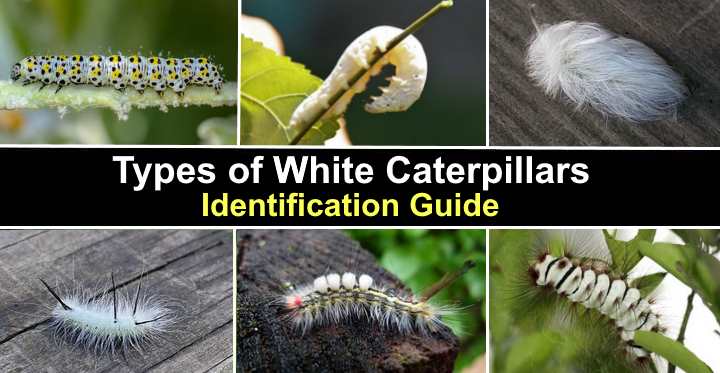
White caterpillars are the larvae of various moth and butterfly species. There are several different types of white caterpillars, all with unique identifying characteristics. For example, many fuzzy white caterpillars like hickory tussock moth caterpillars have stinging spines and cause skin irritation when handled. Others like white flannel moth caterpillars have venom-filled spines. However, not all white furry caterpillars are stinging varieties. Some white caterpillars like the silkworm have smooth bodies and identifiable markings.
Like all species of caterpillars, white caterpillars belong to the insect order Lepidoptera. White caterpillars are smooth or furry and go through several growth stages (instars). During these instars, the white worm-like bugs can change color and appearance. For example, some caterpillars start white and become yellow or brown as they develop. In contrast, other caterpillar species may be white and furry in their last instars.
Caterpillars can’t defend themselves. Therefore, they have various defense mechanisms as protection from predators. For example, some white hairy caterpillars have long pencil-like venomous spines. Other smooth white caterpillars contain bitter-tasting substances, distasteful to birds, insects, and small creatures.
This article is a guide to identifying common types of white caterpillars. Pictures of the white larvae, along with descriptions of their identifying features, will help identify the species of caterpillar you have found in a garden, woodland, or park.
How to Identify White Caterpillars
White caterpillars are long, soft-bodied worm-like insects with six legs and several stumpy prolegs. White is an uncommon color for caterpillars, making them stand out and easy to identify. To identify a specific white caterpillar species, look for black spots, yellowish-white or white setae (fine hairs), and protrusions on its body.
White Fuzzy Caterpillars
Fuzzy white caterpillars are more common than smooth-bodied ones and easy to spot. For example, hickory moth caterpillars have white hairs with a line of black hairy tufts. Although the caterpillars appear white and fluffy, some are covered in venom-filled spines. Other types of white fuzzy larvae are woolly bears, fall webworms, and tiger moth caterpillars.
Are White Caterpillars Venomous?
Some species of white caterpillars have spines containing venom. However, the most well-known toxic white caterpillars are species of flannel moth caterpillars. These furry white caterpillars have hollow hairs connected to poison sacs. When the sharp stinging hairs pierce the skin, toxins are released that feel like a bee’s sting.
Contrary to popular belief, the hickory tussock moth caterpillar is not considered a venomous caterpillar. Instead, its tufts of white and black hairs can pierce the skin causing allergic reactions. However, the caterpillar’s spines don’t contain poison, but the larvae are toxic to birds, making them unpalatable.
There are few venomous (some people incorrectly say poisonous) white caterpillars. But it’s best not to handle furry white caterpillars because they tend to have stinging setae.
Types of White Caterpillars
Let’s look at various types of white caterpillars in more detail — some with fuzzy white bodies, others with smooth white bodies and distinctive markings.
Hickory Tussock Moth Caterpillar (Lophocampa caryae)

The furry black and white hickory tussock caterpillar has stinging hairs
The hickory tussock moth caterpillar is identified by its white and black tufts of hairs. The identifiable black hairy clumps create a black stripe on the back of the caterpillar’s white body. Several long black pencil hairs also stick out from the sides.
Apart from its furry, white and black body, the hickory tussock caterpillar is identified by its black head and black spots along its sides. This black and white hickory tussock moth species measures up to 1.77” (45 mm) long.
The hickory tussock moth caterpillar is not classified as a venomous caterpillar. However, the caterpillar has stinging hairs that embed themselves into your skin, causing allergic reactions and pain in some people. Poison centers report that exposure to a hickory tussock moth caterpillar can cause mild to intense skin rashes and irritation.
The white hickory tussock moth caterpillar turns into a beautiful orange-brown moth with white blotches on its wings. This attractive moth has a hairy, pale brown body and furry, tan-colored head. You’ll find the furry white caterpillar feeding on hickory, walnut, oak, maple, birch, and willow trees.
White caterpillar identification
The hickory tussock moth caterpillar is identified by its covering of black and white hairs on its body and black dots along its sides.
- Adult Stage: The adult hickory tussock moth is a small, white moth with distinctive black markings on its wings.
- Caterpillar Feeds on: The caterpillar feeds on the leaves of various deciduous trees and shrubs, including hickory, walnut, and oak.
- Habitat: These caterpillars can be found in a range of habitats, including gardens, deciduous forests, and wooded areas.
- Stinging: Yes, the hairs of this caterpillar can cause skin irritation.
- Rarity: They are primarily found in North America, particularly in the eastern United States and southern Canada.
Sycamore Tussock Moth Caterpillar (Halysidota harrisii)
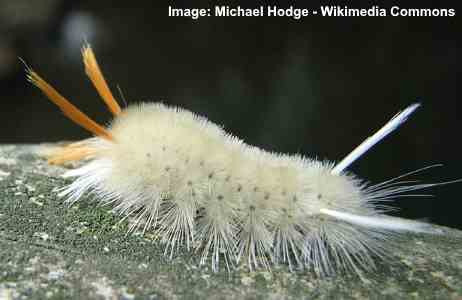
The white or pale yellow furry sycamore tussock caterpillar has an unusual pair of spikes on each end
The sycamore tussock moth caterpillar is a small to medium hairy yellowish-white caterpillar. Identifying features of this white furry caterpillar are two pairs of white pencil hairs and two pairs of orange pencil hairs on either end of its body. White fuzzy sycamore tussock moth caterpillar measures 1” to 1.4” (25 – 35 mm) long.
These white or pale yellow tussock moth species are generally found defoliating sycamore trees. This white caterpillar species is not a stinging variety, but handling one can result in skin irritation. The white caterpillar turns into a pale blue-winged moth.
White caterpillar identification
The sycamore tussock moth caterpillar is identified by its furry white body, and two long tufts of orange and white hairs at each end.
- Adult Stage: The adult sycamore tussock moth has white wings with black spots and a tuft of hair on its back.
- Caterpillar Feeds on: The caterpillar primarily feeds on the leaves of sycamore, maple, and other deciduous trees.
- Habitat: These caterpillars can be found in woodlands and urban areas.
- Stinging: Yes, the hairs of this caterpillar can cause skin irritation.
- Rarity: They are primarily found in North America, particularly in the eastern United States and southern Canada.
American Dagger Moth Caterpillars (Acronicta americana)
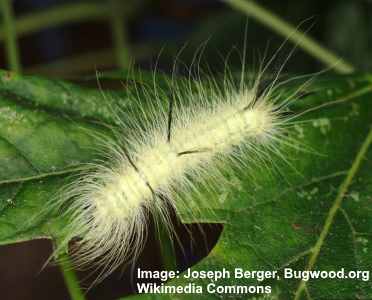
The American dagger caterpillar can be identified by its distinct white-yellowish hairy look
The American dagger moth caterpillar is a hairy, pale yellowish-white caterpillar with several pencil-like tufts of black hairs. The caterpillar is covered in white hairs, and it has a shiny black head and two greenish stripes along its back. The pale yellow or white bugs grow up to 2” (50 mm) long.
The white American dagger moth larva is not venomous. Although the fine setae will cause a lot of skin irritation, they are not venom-filled spines on this species. You will find this native caterpillar chewing through foliage in deciduous forests and woodlands.
White caterpillar identification
The American dagger moth caterpillar is identified by its covering of fine whitish hairs, two pairs of long black tufts, and one more prominent black tuft at its tail end.
- Adult Stage: The adult American dagger moth is a medium-sized moth with brownish-gray wings adorned with distinctive dark markings.
- Caterpillar Feeds on: The caterpillar feeds on the leaves of various deciduous trees and shrubs, including oak and maple.
- Habitat: These caterpillars inhabit gardens, deciduous forests, and wooded areas.
- Stinging: Yes, the hairs of this caterpillar can cause skin irritation.
- Rarity: They are primarily found in North America, particularly in the eastern United States and southern Canada.
Fall Webworm (Hyphantria cunea)
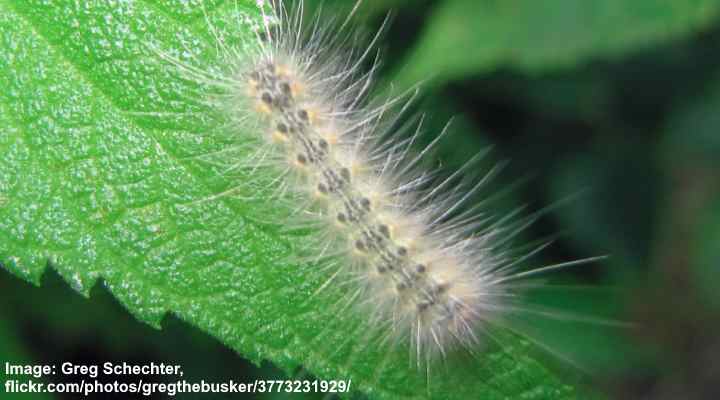
The white hairy fall webworm can cause a lot of damage to shrubs and trees
The fall webworm is a native hairy white or pale-yellow caterpillar that spins characteristic tent-like webs where hoards of caterpillars live. The fall webworm is identified by its long white setae growing from yellowish tufts on a dark body. Fall webworms can have bright red or dark shiny black heads, depending on the climate.
The fall webworm doesn’t grow longer than 1.4” (35 mm) long. The destructive pests can defoliate ornamental shrubs and trees. After pupation, these hairy whitish caterpillars turn into brilliant white moths, sometimes with black speckled markings on the forewings.
White caterpillar identification
The white fall webworm is identified by its long, wispy white hairs, two rows of black spots on its back, and a rounded black head.
- Adult Stage: The adult fall webworm moth is a white moth with small black spots on its wings.
- Caterpillar Feeds on: The caterpillar feeds on the leaves of a wide range of deciduous trees and often creates silken web nests.
- Habitat: These caterpillars can be found in gardens, orchards, and woodlands.
- Stinging: No, they do not have stinging hairs.
- Rarity: They are found in North America, Europe, and Asia.
Virginian Tiger Moth Caterpillar (Spilosoma virginica)
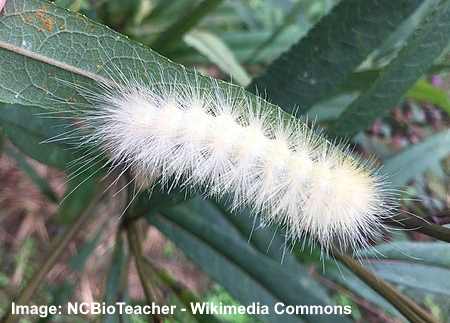
The Virginian tiger caterpillar has irritating fuzzy hairs and it can vary in color from white, light to dark brown, and even yellow or orange
The Virginian tiger moth caterpillar is a pure white woolly bear larva covered in tufts of light tan to white hairs. The furry caterpillar can also be rusty brown or pale yellow in color. Also called the yellow woolly bear, the caterpillar grows up to 1.77” (45 mm) long.
The pale to dark brown or white furry caterpillar turns into a spectacular white moth with a line of identifiable black dots on its body. The destructive larvae skeletonize leaves in late summer.
White caterpillar identification
The Virginian tiger moth caterpillar is identified by its spiky appearance consisting of tufts of creamy-white or tan-white hairs. Despite coloration differences in the species, the furry caterpillars are always a single color.
- Adult Stage: The adult Virginian tiger moth has white wings with black spots and an orange abdomen.
- Caterpillar Feeds on: The caterpillar primarily feeds on various herbaceous plants and sometimes garden crops.
- Habitat: These caterpillars are often found in gardens and meadows.
- Stinging: No, they do not have stinging hairs.
- Rarity: They are found in North America, particularly in the eastern and southeastern United States.
Spotted Apatelodes Caterpillar (Apatelodes torrefacta)
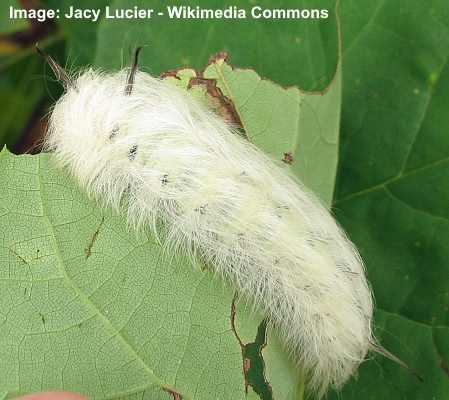
The spotted apatelodes caterpillar starts as a furry white caterpillar and turns into bright yellow
The spotted apatelodes is the hairy white caterpillar of an unusual gray moth. The young fuzzy caterpillars are brilliant white and gradually turn creamy white then neon yellow. The woolly white caterpillar has black spines on its body and a clump of grayish-black long spines at its head.
The white hairy caterpillar is hard to miss against green foliage. You’ll often find these non-stinging, unusual caterpillars on maples, ash, and oak trees. Expect the fuzzy white, distinctive caterpillars to grow between 0.78” to 1.77” (20 – 45 mm) long as they go through the growth stages from white to bright yellow.
White caterpillar identification
The spotted apatelodes moth caterpillar is covered in wispy white hairs and has identifiable long black tufts on its back and black spots along its sides.
- Adult Stage: The adult apatelodes moth is a medium-sized, fuzzy moth.
- Caterpillar Feeds on: The caterpillar feeds on the leaves of oak, hickory, and other hardwood trees.
- Habitat: These caterpillars can be found in woodlands and gardens.
- Stinging: No, they do not have stinging hairs.
- Rarity: They are primarily found in North America.
White-Marked Tussock Furry Horned Caterpillar (Orgyia leucostigma)
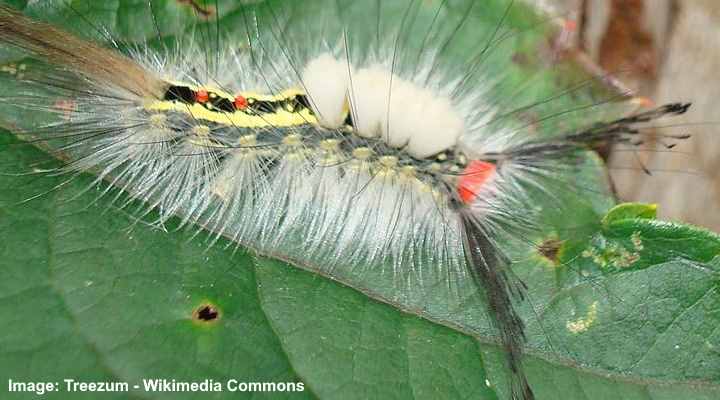
The furry white-marked tussock caterpillar is easily identified by its unique look
The white-marked tussock horned caterpillar is one of the most unusual furry caterpillars you will come across. The caterpillars are identified by their large white tufts of hairs, hair pencils of black setae, red head, and black and yellow stripes. The strange-looking colorful caterpillars grow 1” to 1.5” (25 – 38 mm) long.
The white-marked tussock furry larva is a typical Florida caterpillar. The spiky caterpillar feeds on various deciduous and coniferous trees. The pesky larvae can defoliate hickory, larch, birch, black locust, willow, and elm trees. It also can destroy leaves on various fruit trees.
White caterpillar identification
The white-marked tussock moth caterpillar is easily identifiable due to its bright colors, four fluffy white tufts on its back, and tufts of pencil hairs around its body.
- Adult Stage: The adult white-marked tussock moth is a small, white moth with distinctive markings.
- Caterpillar Feeds on: The caterpillar feeds on the leaves of various trees and shrubs.
- Habitat: These caterpillars can be found in woodlands, gardens, and urban areas.
- Stinging: Yes, the hairs of this caterpillar can cause skin irritation.
- Rarity: They are primarily found in North America.
Domestic Silk Moth Caterpillar (Bombyx mori)
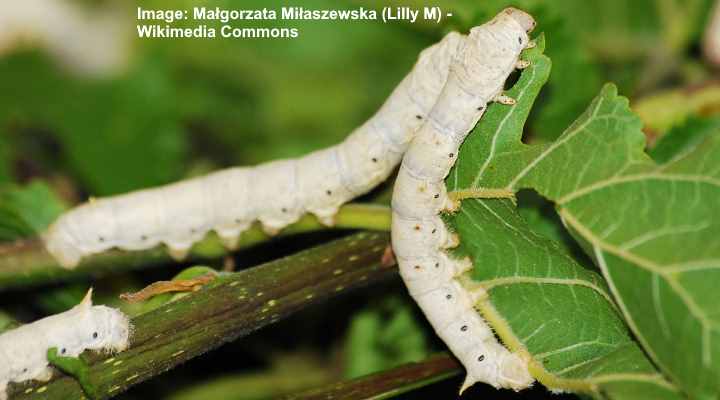
The domestic silkworm has a smooth white body with a small horn at the back
The domestic silk moth caterpillar is classified as a white silkworm that feeds on mulberry leaves. The white, smooth-bodied caterpillars have a tiny horn on their back, a single black dot on each segment, and yellowish-white feet. The white worm-like bugs grow 1.5” (40 mm) long.
Also called mulberry silkworms, the white caterpillars are famous in silk production. Their cocoons are harvested to produce high-quality raw silk.
White caterpillar identification
The domestic silkworm is identified by its white, slender body, yellowish horn at its tail end, three pairs of spotted front legs, and a row of black dots along its sides.
- Adult Stage: The adult domestic silk moth is a large, white moth.
- Caterpillar Feeds on: The caterpillar feeds exclusively on the leaves of the mulberry tree.
- Habitat: These caterpillars are raised on domesticated silk farms.
- Stinging: No, they do not have stinging hairs.
- Rarity: They are cultivated worldwide for silk production.
Catalpa Sphinx Caterpillar (Ceratomia catalpa)
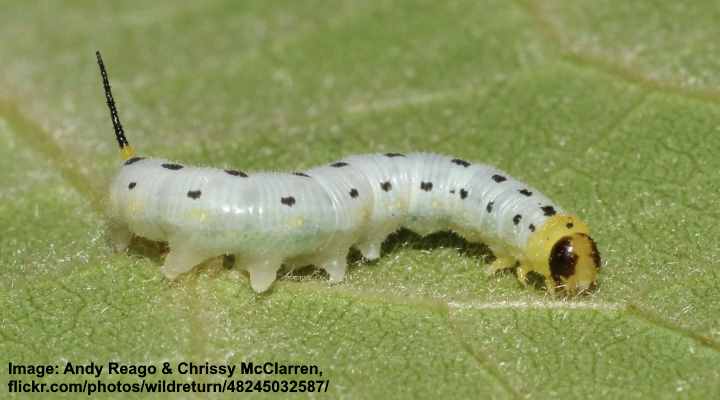
The large catalpa sphinx caterpillar has a smooth white body with black dots, yellow and black head and black tail horn
The catalpa sphinx moth caterpillar is a large, stout-bodied white hornworm with a pale yellow and black head, three rows of black dots, and a conspicuous black tail horn. The distinctive creamy-white caterpillar grows up to 3” (75 mm) long and becomes yellower as it reaches its final instar.
The white grubs are often found feeding on the leaves of catalpa trees. Also called the Catawba worm, these are the only white caterpillars you’ll find on catalpa trees.
This smooth white caterpillar turns into a pale brown sphinx moth with a plump, hairy body and triangular wings.
White caterpillar identification
The catalpa sphinx moth caterpillars have a white body, black spots, and a pointed horn. As the white caterpillars grow, the black dots merge to become black stripes, giving the caterpillar a black and pale-yellow striped appearance.
- Adult Stage: The adult catalpa sphinx moth is a large, brown moth.
- Caterpillar Feeds on: The caterpillar feeds on the leaves of catalpa trees.
- Habitat: These caterpillars can be found in woodlands and gardens.
- Stinging: No, they do not have stinging hairs.
- Rarity: They are primarily found in North America.
Virginia Ctenucha Caterpillar (Ctenucha virginica)
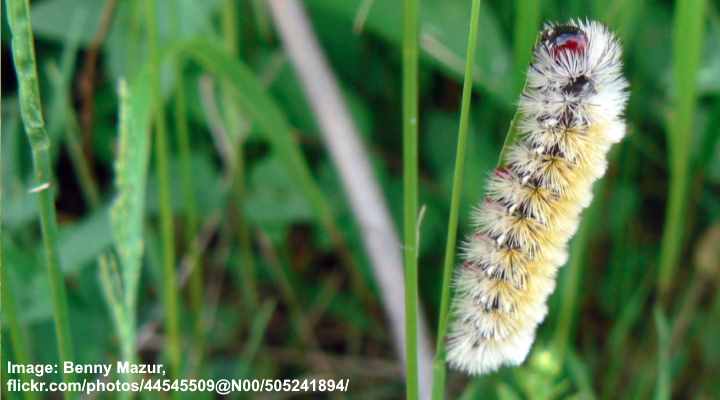
The small Virginia ctenucha caterpillar has white and yellow hairs and red head
The Virginia ctenucha is a type of fuzzy white caterpillar. It has dense creamy-white tufts of hairs covering black body giving it a whitish appearance. Other features of the fuzzy caterpillar are a black and red shiny head, white and yellowish tufts of bristles, and dark red prolegs. The tiny caterpillars grow 0.8” to 1” (20 – 25 mm) long.
You can find these hairy caterpillars feeding on various types of grasses and iris plants. The bristly white and yellow caterpillars are easily recognizable hairy larvae. As the small white caterpillars grow, they become dark black caterpillars.
White caterpillar identification
The Virginia ctenucha is a small furry white caterpillar that becomes black as it approaches the pupal stage.
- Adult Stage: The adult Virginia ctenucha moth is a black and orange wasp-like moth.
- Caterpillar Feeds on: The caterpillar primarily feeds on various grasses.
- Habitat: These caterpillars are often found in meadows and grassy areas.
- Stinging: No, they do not have stinging hairs.
- Rarity: They are primarily found in North America.
Hieroglyphic Moth Caterpillar (Diphthera festiva)
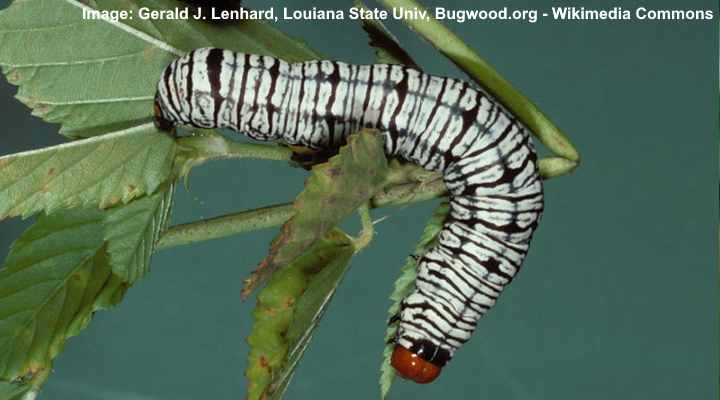
The hieroglyphic caterpillar has a white smooth body with black and gray stripes and reddish head
The hieroglyphic moth caterpillar is a white caterpillar with black and gray bands around its plump body. The stunning, black-striped, white caterpillar is also identified by its white and black legs, and an orange-red head. The large caterpillars grow up to 1.77” (45 mm).
These black and white caterpillars can cause a lot of damage to crops. The caterpillars are common in Florida and other southern states and feed on the leaves of sweet potato, pecan, and soybean plants.
White caterpillar identification
The hieroglyphic moth caterpillar is identified by its cream-colored body and grayish-black bands around the cylindrical body.
- Adult Stage: The adult hieroglyphic moth is a large, brown moth with intricate markings.
- Caterpillar Feeds on: The caterpillar feeds on the leaves of various hardwood trees.
- Habitat: These caterpillars can be found in woodlands and gardens.
- Stinging: No, they do not have stinging hairs.
- Rarity: They are primarily found in North America.
Rubber Tree Caterpillar (Lymire edwardsii)
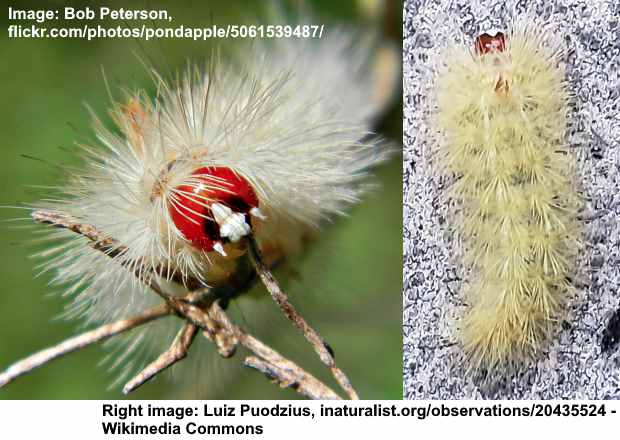
The yellowish-white furry rubber tree caterpillar has red and white head
The rubber tree caterpillar is a yellowish-white or pale-yellow larva with a spiny appearance. The hairy caterpillar has white spines that become a deeper yellow as it matures. In addition, the caterpillar has an identifiable crimson red and white head and orangey tufts. These furry, non-venomous white caterpillars are relatively small.
As the name suggests, rubber tree caterpillars are common pests of the Ficus species. The voracious furry bugs chew ficus leaf edges, creating holes in the leaves. You will often find these hairy yellowish-white caterpillars on plants in Florida.
White caterpillar identification
The rubber tree caterpillar is identified as a furry white or yellow caterpillar that turns into the Edwards’ wasp moth.
- Adult Stage: The adult rubber tree moth is a small, inconspicuous moth.
- Caterpillar Feeds on: The caterpillar feeds on the leaves of rubber trees.
- Habitat: These caterpillars are found in rubber tree plantations.
- Stinging: No, they do not have stinging hairs.
- Rarity: They are primarily found in Southeast Asia.
Dogwood Sawfly Caterpillar (Macremphytus testaceus)
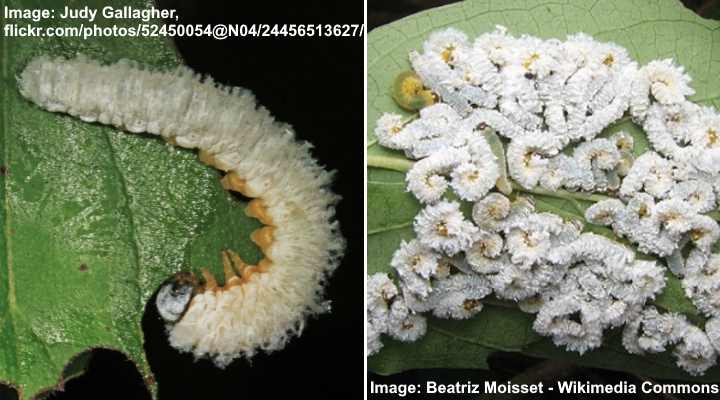
The small dogwood sawfly caterpillar has a white fluffy body with yellow legs
The dogwood sawfly caterpillar is a brilliant white fluffy caterpillar with yellow legs. The fuzzy-looking white larvae are often seen curled up underneath dogwood foliage. As the bugs develop, they become more translucent and develop a yellowish head. The small white caterpillars measure 0.8” (20 mm) long.
These white worm-like caterpillars are easy to identify because they are only found on dogwood shrubs and trees. The white bugs are active in mid to late summer and skeletonize leaves. The creamy-white caterpillars overwinter in rotted wood, and the sawflies emerge the following spring.
White caterpillar identification
The white dogwood sawfly caterpillar is identified by its white, waxy coating in its second instar. As the caterpillar matures, it becomes yellow and black.
- Adult Stage: The adult dogwood sawfly is a wasp-like insect.
- Caterpillar Feeds on: The caterpillar feeds on dogwood leaves.
- Habitat: These caterpillars can be found in woodlands and gardens.
- Stinging: No, they do not have stinging hairs.
- Rarity: They are primarily found in North America.
Figwort Sawfly Caterpillar (Tenthredo scrophulariae)
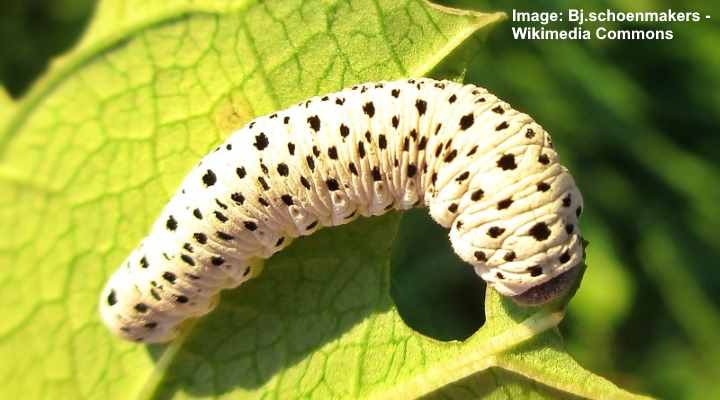
The white wrinkly body of the figwort sawfly caterpillar is covered with black spots
The figwort sawfly caterpillar is a large, stout white, black-spotted caterpillar that grows to 1.18” (30 mm) long. The plump, sausage-like white larva has a distinctive crinkled appearance, a grayish-black head, and a slightly tapered tail end. The white caterpillars are found feeding on figwort plants in late summer and early fall.
These large white and black-dotted caterpillars turn into small wasp-like sawflies that are black with yellow stripes. The difference between figwort sawflies and wasps is that they lack the thin waist, characteristic of wasp species.
White caterpillar identification
The figwort sawfly caterpillar is identified as a fat, dusty-white larva with black spots and a creased appearance.
- Adult Stage: The adult figwort sawfly is a wasp-like insect.
- Caterpillar Feeds on: The caterpillar feeds on figwort and other herbaceous plants.
- Habitat: These caterpillars are often found in meadows and gardens.
- Stinging: No, they do not have stinging hairs.
- Rarity: They are found in Europe, Asia, and North America.
elated articles:
